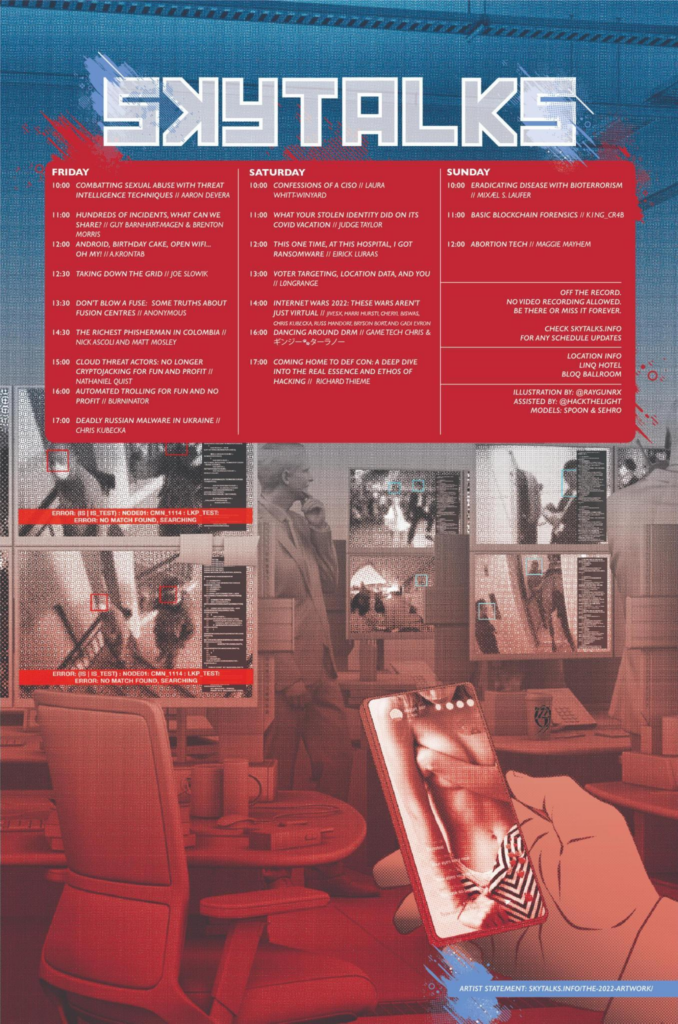But First, A Statement From the Artists…
Facial recognition technology (FRT) was the idea and issue we had planned for the 2020 SKYTALKS poster. In 2020, the European Commission banned facial recognition technology in public spaces for up to five years to create change for their legal framework and include guidelines on privacy and ethical abuse. FRT was a hot topic. With the extra time on my hands, I had the chance to dip my toes while it was warm.
Fast-forward two turbulent years to today, the tea is still hot and facial recognition technology has become expansive. It as been implimented by technology platforms, financial instituations, and even the MLB. Escalating cybersecurity has pushed the need for securing physical and online spaces. As a result, biometric authentication, such as facial recognition – can be expected to be part of the security landscape.
FRT’s growth has led to complex choices in balancing individual privacy rights versus delivering societal safety. Law enforcement agencies use of FRT has given us a lens of the risks of its application.
“Facial recognition can be incredibly harmful when it’s inaccurate and incredibly oppressive the more accurate it gets.” – Woodrow Hartzog (Law Professor & Scholar)
Even if accurate, face recognition empowers a law enforcement system with a long history of racist and anti-activist surveillance and can widen pre-existing inequalities.
COVID-19 has further pushed the boundaries of privacy, with countries introducing measures to track travel and connections to contain the spread of the virus. With the spread of the virus, masks are mandatory in public places or at certain events, which interferes with FRT software.
FRT’s growth has led to complicated choices in balancing individual rights and delivering societal safety. It makes us ask: What is the ethical extent of citizen surveillance?
We have an image of a command center room with monitors and “suits.” I have a half-toned image of the highly-recognizable Mr. Bean. There is the dance competition scene from the musical Grease. We have a POV shot of a security person, distracted and drawn to the beauty and power of a woman’s figure – not noticing the two 303 members waving to the surveillance camera.
COVID-19 took a lot away from us in 2020. This year in June 2022, the overturning of Roe vs. Wade took away the constitutional right to an abortion – the first time a constitutional right in American history was overturned.
There is still so much societal judgment about what a woman does with her body. There is judgment in if a woman is a mother and/or sex worker. Even with the push for women empowerment, there are varying opinions on what it looks like. The image of the woman on the phone is a tribute to all the women sex workers affected by COVID-19.
There is an overwhelming amount of legislation oppressing women with what we are allowed to do with our bodies. Find a way to be an ally to the girls and women who have lost human rights to medical care and could die while we all figure it out.
@raygunrx
Please some time to read these articles.
Regulating facial recognition in the EU
https://www.europarl.europa.eu/RegData/etudes/IDAN/2021/698021/EPRS_IDA(2021)698021_EN.pdf
The ethics of facial recognition technologies, surveillance, and accountability in an age of artificial intelligence: a comparative analysis of US, EU, and UK regulatory frameworks
https://link.springer.com/article/10.1007/s43681-021-00077-w
Racial Discrimination in Face Recognition Technology
https://sitn.hms.harvard.edu/flash/2020/racial-discrimination-in-face-recognition-technology/
WHAT IS FACIAL RECOGNITION TECHNOLOGY?
https://www.ajl.org/facial-recognition-technology
https://www.npr.org/series/1096684820/roe-v-wade-and-the-future-of-reproductive-rights-in-america
https://www.nytimes.com/interactive/2022/us/abortion-laws-roe-v-wade.html
… and a word from bluknight, too:
This year’s art was more than a little controversial because of the imagery that we originally selected for the “distraction”. There were people who felt that the image we originally presented was not confident or powerful, but was someone who was trying to hide.
I personally disagree with that evaluation. The artwork, as printed, is not what was originally envisioned, and I try to support the artist’s vision wherever I can.
Women can and do express their sexual power in different ways, even by “being submissive”. The point that Reagan was trying to make, in my opinion, is valid, no matter in what way a woman uses to wield and express her power.
The first image below is the version of the artwork as printed in the DEF CON program. The second image is what we originally concieved and submitted. We invite you to evaluate for yourself and discuss with it.
–bluknight

